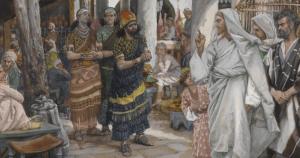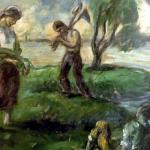What can we glean from the Creation accounts about the body? Does the Word of God speak concretely about the physical body? How far do we go in applying the terms image and likeness of God (the imago Dei)?
Do we practically apply scriptural principles to our everyday?
Could we incorporate these views into our approach as ministers, therapists, etc.?
I simply cannot tackle all these questions (and those following) in this portion of the series.[1] However, sometimes it’s better to raise a few questions for people to grapple with, rather than to provide all the answers.
i. Adam: The Body
Image
Man is the being, but the image and the likeness are God’s (Genesis 1.26-27). James Strong simply defines image as a, “a representative figure, especially an idol”[2] An idol represents something spiritual, like a demon. It is an inanimate object that looks like the “god” it represents.
In the same way, man is the image or representation of God (imago Dei). “We have special value in that we are the only aspect of creation specifically said to be created in God’s ‘image.’”[3] The image represents God, but is also handcrafted by God from the clay. He speaks all of creation into existence except for man, who He makes by hand and gives His very breath to.
Distinctions of the human body
Although some gender differences can be attributed to culture, God creates male and female (Genesis 1.27; 2.18-22). In the garden, these differences are complimentary, not divisive (Genesis 2.18).
The body is able to perceive and to respond to its surroundings through the five senses. The body is able to perform behavior. Adam’s first behavior is to take care of the garden (Genesis 2.15).
The body is able to communicate meaning. God brought all of the animals to Adam, “to see what he would call them” (Genesis 2.19). “Man alone has language, and can give birth to languages. In giving names to earth’s creatures, he would establish his dominion over them.”[4]
The body is also capable of rest, which is a sanctified activity (Genesis 2.2-3).
ii. Adam’s Fall: from God’s Image to Man’s
The original couple is unashamed of their naked bodies (Genesis 2.25, 3.7). After they eat the fruit, they experience shame. They cover themselves and hide their bodies from God. The image is marred. Eventually, the fallen image is reproduced.
And Adam lived an hundred and thirty years, and begat a son in his own likeness, and after his image; and called his name Seth. (Genesis 5.3)
Does this mean that man no longer bears God’s image?
“Old Testament writers spoke of the brevity of life and humanity’s relative physical insignificance, they affirm that our glory is found in the fact that we are in the image of God.”[5] God’s image is still within man. However, man is unable to reproduce the whole image of God. So man is now a distorted image and likeness of God, in need of redemption.
iii. The 2nd Adam: from Man’s Image to Renewal
John Ingram states that, “the body, or the actual physical flesh, is not inherently evil, although it can be used instrumentally for either positive or negative purposes.”[6]
The body is not capable of living forever, and eventually dies.
On the cross, Jesus Christ sacrifices His body to restore ours. God not only grants us healing now, but eventually a new body, a renewal of the image of God that will live forever.
 James Tissot | The Healing of the Officer’s Son
James Tissot | The Healing of the Officer’s Son
circa 1886 | Brooklyn Museum | Public Domain
The minister and counselor can participate in the healing process with the client.
Perhaps the client suffers from a poor body image or is in need of physical healing. Certainly, God has the power to provide emotional or physical healing.
Perhaps other interventions are necessary. A note of caution is that we can risk harm to a client’s body by, “applying only religious interventions to problems that may require medication or other medical or psychological treatments.”[7]
Ultimately, counselors and ministers who help people find appropriate medical treatment are still participating in a form of God’s healing processes.
Questions to Consider:
1) How would we practically apply scriptural principles to our everyday?
2) What is you view about physical healing? Does your congregation have an official statement about divine healing?
3) Do you hold a view about emotional healing?
4) How could these Scriptures speak to those with body image issues? What about other physical issues?
5) Do you consider medical/health intervention as a grace of wisdom for the body? Of course, many treatments are reactive, but there are also proactive ways we can become healthier.
6) Do we have a responsibility as ministers and therapists to consider the overall health of the body? How do we form an approach as ministers, therapists, etc.?
Footnotes:
[1] Jared V. Ingle, “Nine Biblical Factors of Personality, Abnormality, and Change in the Creation Account,” (paper presented in Interpersonal Techniques in Helping Relationships, Assemblies of God Theological Seminary, Springfield, MO, December 9, 2003).Toward a Biblical Concept of Personality
On Holism, Holiness, and Wholeness
[2] James Strong, The Exhaustive Concordance of the Bible (Peabody, MA: Hendrickson Publishers, 1961), 99.Amazon: Strong’s Concordance [3] Stanton Jones and Richard Butman, Modern Psychotherapies: A Comprehensive Christian Appraisal (Downers Grove, IL: InterVarsity Press, 1991), 42.
Amazon: Modern Psychotherapies [4] J.H. Hertz, The Pentateuch and Haftorahs, 2nd ed. (London: Soncino Press, 1960), 9.
Amazon: Pentateuch and Haftorahs [5] John D. Carter and S. Bruce Narramore, The Integration of Psychology and Theology: An Introduction (Grand Rapids, MI: Zondervan, 1979), 21.
Amazon:Integration of Psychology and Theology













